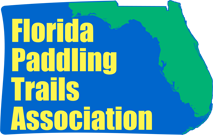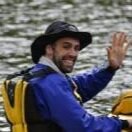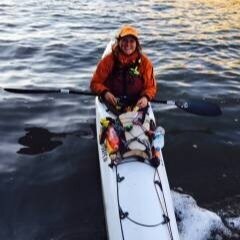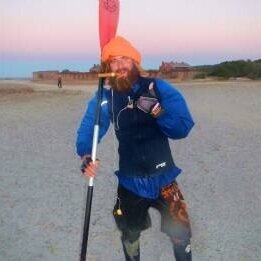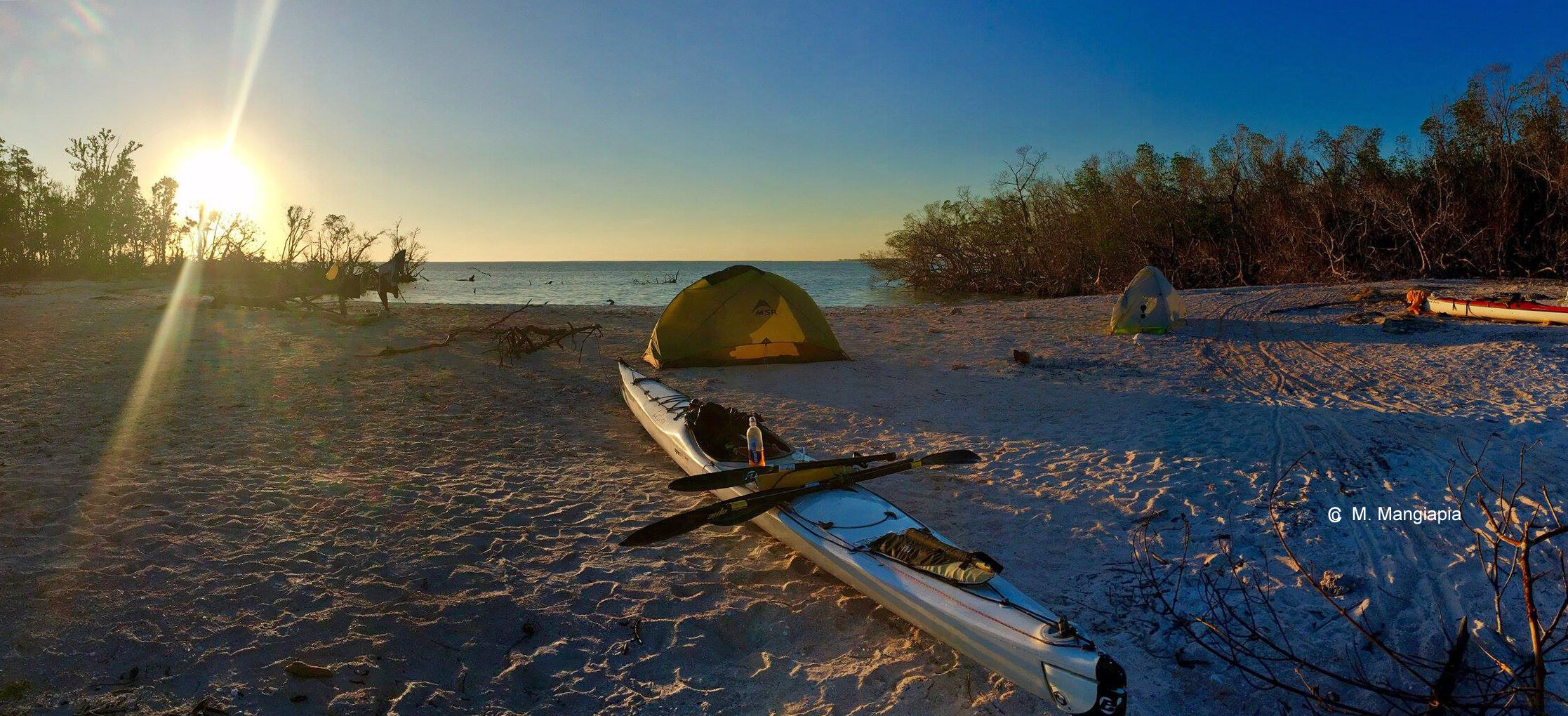
The Circumnavigational Trail (CT)
FPTA's founding centered on Florida’s 1,515-mile “CT”— the Florida Circumnavigational Saltwater Paddling Trail. Learn more about the trail and the paddlers who have completed it.
ABOUT
In 2005, the 1515-mile Circumnavigational Saltwater Paddling Trail (or “CT”) was officially designated by the Florida Legislature as part of the Florida Greenways and Trails System (Title XVIII, Chapter 260 Florida Statutes). Scouting for the trail was completed in the summer of 2007. Another highlight that summer was its designation as a National Recreation Trail by the United States Department of Interior.
Beginning at Big Lagoon State Park near Pensacola, extending around the Florida peninsula and Keys, and ending at Fort Clinch State Park near the Georgia border, the Florida Circumnavigational Saltwater Paddling Trail (commonly referred to as The CT) is a 1,515-mile sea kayaking paradise. The trail includes every Florida coastal habitat type, from barrier island dune systems to salt marsh to mangroves. Numerous historical sites and points of interest are accessible by kayak along with colorful fishing communities and urban centers.
The CT is divided into 26 segments. Each segment is unique, ranging from the remote Big Bend Coast and Everglades/Florida Bay wilderness, to the more urbanized coastlines of Pinellas County and Fort Lauderdale. The trail is utilized by thousands of Florida residents and visitors alike who paddle the trail for a few hours, days, weeks or months. Some hardy souls have paddled the entire trail, and others seek to complete the trail in segments over several years, similar to how hikers often tackle the Florida or Appalachian Trail. The trail is laid out in a counter-clockwise direction, although people can paddle it in either direction. If you plan to shuttle vehicles while paddling along the CT please see the Overnight parking link below.
CT paddlers tend to fall into two categories, "through paddlers" and "section paddlers." "Through paddlers" paddle the CT during one paddling season, usually from two to four months, while "segment paddlers" generally paddle a few days at a time and may take several years to complete the entire CT. These paddlers have the advantage of choosing their weather, tides and paddle direction. Regardless of your approach to paddling the CT, you will find it an incredibly enriching way to experience Florida's long coastline, and one that few people ever experience. Remember, it is more about the journey than the destination!
Volunteer Trail Keepers help maintain primitive campsites and 'adopt' stretches of this long-distance trail. We always need more assistance so please consider signing on as a Trail Keeper to help keep this iconic trail a treasure for all paddlers to enjoy. If you want to be part of our fun and dedicated team of Trail Keeper volunteers, click here.
TRIP PLANNER
Maps
The below maps are intended to be used along with the latest Edition of the Florida Circumnavigational Saltwater Paddling Trail Guide (Text Only) and are for general information only. NOAA maps should be used for navigation purposes. Please review the CT Updates link (below) for changes since the last edition of the Text Only CT Guide. Boat ramps, campsites, motels, etc. along the CT may occasionally change, or not be available due to weather damage, change of ownership, etc. It’s best to call ahead to make sure the places on your itinerary are open. If you notice any situations that have changed from the maps or the Trail Guide, please let us know so we can update the information.
Interactive Map (Click on upper right box to open full page, scroll in to expand and click on the icons for additional information) The below map favors the more protected Alternate routes in Segments 2,3 and 4.
Legend
CT Updates (Important changes since the last Trail Guide, 7th Edition was published)
Downloadable Maps and KMZs (Click on link to open)
Complete CT Downloadable KMZ (One File, click on link to open)
DEP/OGT Map Site (Click on link to open)
Recommended Gear
Boat - 14 1/2’ minimum, preferably a sit inside with 2 watertight compartments. Generally the longer and narrower the boat, the faster it is, and
less work required. Paddle, spare paddle, spray skirt, cockpit cover, built in compass, painter, emergency repair kit
Safety/Navigation – PFD, whistle, first aid kit with medications, VHF radio, GPS, Satellite InReach or Spot Messenger, Cell Phone, headlamp, solar
panel and battery pack for charging all electronics, laser flare/standard flares, bilge pump, small compass for PFD, tow rope, paddle float,
multitool, charts, sunscreen
Camp – Lightweight 2 man tent, inflatable mattress & pillow, sleeping bag and sheet, small lightweight tarp, 50’ of parachute cord, camp shoes,
chair, small folding table, sleeping bag, cooking gear, waterproof matches, lighter, camp clothes, headlamp, spare
batteries for all electronics, small fire logs/fire starter, Thermacell, bug repellent, etc.
Clothes - This depends on the weather. Quick dry synthetic shirts and pants, hat, sunglasses, buff, water shoes or neoprene booties, dry camp
shoes, wool socks, lightweight goose down jacket, rain gear
Toiletries - Biodegradable soap, toilet paper, wet wipes, small towel and wash cloth, small lightweight shovel for digging catholes, toothbrush and
toothpaste
Water – Recommend 2L Platypus soft bags, 3L/day. Always bring enough water for a couple of extra days as a precaution.
Food - This depends on your tastes, but realize that you burn a lot of calories in a day when paddling, so always carry plenty of high energy
meals and snacks with you. Always bring enough food for a couple of extra days as a precaution.
Safety Tips
Always wear a PFD, preferably a bright colored one. Check to make sure it is in good condition before departure.
File a float plan. Where you are leaving your vehicle, where you are going, who is with you, what your kayak looks like, and where and what day/time you plan to finish. Instruct the person holding the float plan to notify the Coast Guard or other appropriate agency if you do not return within a reasonable time after your scheduled arrival (taking into account weather, etc.).
Try to paddle with a partner when possible .
Carry a cell phone, GPS and a satellite communicator with SOS capabilities. Make sure all are in working order before starting, and you have a spare set of batteries for everything.
Carry a head lamp in case your paddle trip extends after dark.
Carry a emergency space blanket in case of hypothermia.
Stay hydrated.
Check the weather just before departure.
Take a course on, and be proficient in basic paddle strokes, wet exits, self-rescue and assisted rescues.
Make sure you have a FPTA "IF FOUND - CONTACT" sticker on your paddlecraft in case you get separated from it.
FAQs
How do I get started?
Once you’ve made up your mind to tackle the CT, and you’ve done the planning, register here. Help support our organization by becoming a member here! Upon completing the CT, to be eligible for a free FPTA lifetime membership, you must be a member during your CT attempt.
How do I enlist the help of the FPTA Trail Angel network?
First, you must be a FPTA member. If not currently a member, start your membership here. Once you complete the CT, you will be granted a free lifetime membership. Next, go to the Director’s page, and contact the Director in the Region that you will be paddling in, and apprise her/him of your plans. Please be aware that Trail Angels are volunteers and are not available 24/7, especially if Region Directors are notified at the last minute. Please be considerate with your expectations.
How long does it take to paddle the whole trail?
Depending on your skill level, most paddlers take about 90 to 100 paddle days to complete the entire trail. This does not include “zero days” (days when you are unable to paddle due illness, injury, equipment failure, or inclement weather).
What is the most difficult section to paddle?
There is no one section that is the most difficult to paddle, but generally, any open water, passes, and inlets, and shipping channels have more potential for being difficult. Difficulty can depend on a multitude of factors, including but not limited to, wind speed and direction, temperature, fog, rain, tides, tidal current, wave height, etc.
Should I through paddle, or section paddle?
A major determining factor is how much time you have to dedicate to this goal. Depending on your paddling skills and endurance, most through paddlers take between 3 and 4 months. Through paddling takes considerable logistical planning for necessary reservations and resupplying. If you don’t have this amount of time, section paddling is a great alternative, and there is no time limit to complete the trail. Section paddling allows you to choose paddling when the weather, wind speed and direction, season, etc. is to your advantage, but requires planning for shuttles when getting on and off the water. Section planning, however, is no guarantee that you won’t face hardships while on the trail.
Can I paddle in either direction?
Yes, through paddlers can paddle clockwise or counter clockwise. Section paddlers can paddle any section in either direction.
How do I keep track of where I’ve been?
Most CTers keep a simple log, however there are alternative methods, such as, keeping a spreadsheet, keeping your daily tracks on your GPS device or GPS app, and keeping your daily tracks on Google Earth using the Ruler>Path tool to draw in your daily tracks. The latter is a great visual approach to recording your trip, as it automatically includes your daily mileage, and you can add additional information if you wish.
Do I have to turn in documentation after I complete the CT?
No, completing the CT is on the honor system.
Do I have to paddle the Keys both ways?
No, one direction is all that is required.
How do I get into the CT Hall of Fame?
Inductees into the CT Hall of Fame must meet the following criteria:
1. The main source of propulsion must be a paddle.
2. Only sails under one meter squared are allowed.
3. All launch and take out points must connect to form a continuous line around the State (Key Largo to Key West section only has to be completed once). The Trail may be paddled in either direction.
4. All paddlers must practice Leave No Trace principles.
Books About the CT (Click on links to open)
“Florida Circumnavigational Saltwater Paddling Trail” 7th Edition FL Office of Greenways and Trails
“Waters Less Traveled” by Doug Alderson
“A Heartfelt Wanderer: The Sunshine Expedition” by Jodi Eller
“L-earn-ing Every Stroke - A 1,500-mile Kayak Adventure Along the Florida Coast” by Jeffrey “Treehouse” Buncie
“Big Bend Saltwater Paddling Guide” by FWC
Other Important Links
Overnight Parking along the CT
CT Updates (Important changes since the last Trail Guide, 7th Edition was published)
Big Bend Saltwater Paddling Trail Safety Video
Explore Paddler's Trip Reports
Kayak Around Florida (Marc DeLuca & Jim Wendle)
Thru-Paddling Florida (Mike Ruso & Dan Dick)
BNC Odysseia (Jeff Buncie)
Go Kayak Florida (Sean Bower)
Warren Johnson
Daniel Alvarez
Jake Stachovak
THE CT HALL OF FAME
This PowerPoint presentation from 2015 is about those who have paddled the entire trail, those who have completed significant portions, and those special "trail angels" who assist paddlers along the way. For information on the trail angel network click here.
An annual CT paddlers reunion, made up of those who have completed the trail and those who support it, is usually held at a state park. An exception was 2020, due to the Covid pandemic.
Inductees into the CT Hall of Fame must meet the following criteria:
1. The main source of propulsion must be a paddle.
2. Only sails under one meter squared are allowed.
3. All launch and take out points must connect to form a continuous line around the State (Key Largo to Key West section only has to be completed once). The Trail may be paddled in either direction.
4. All paddlers must practice Leave No Trace principles.
Paddlers Who Have Completed the CT
The paddling season of 2008 and early 2009 marked the first attempts by people to paddle the entire circumnavigational trail (CT). Through their feedback and suggestions, these explorers helped state planners improve the trail and open the way for other paddlers. The FPTA network of volunteers often serves as a type of AAA on the water to assist long distance paddlers. Paddlers can complete the trail by segments over several years (segment, or section paddling) or in one paddling season (through paddling), but all segments (including at least one direction in the Keys) must be paddled to complete the CT.
Matt Keene, CT1 of Clermont, Fl, began Sept 15, 2008 at Ft. Clinch and ended Jan 5, 2009 at Big Lagoon State Park, Pensacola, Fl. He was the first paddler to complete the entire trail since it was established. He was accompanied part of the way by two other companions, Jodi Eller and Matt Gallagher. Several FPTA volunteers helped along the way. He and Jodi (now married) then backpacked the entire Florida Trail. Matt is currently the FPTA director for Region K (Space Coast).
Mike Ruso, CT2 and Dan Dick, CT3 started on November 12, 2008, at Big Lagoon State Park near Pensacola and finished on March 26 2009. They are the first west to east paddlers to finish the trail. They had a SPOT Messenger device that allowed people to track their movements on their website. Mike developed an informative and practical guide for those interested in paddling the circumnavigational trail: http://thrupaddlingflorida.jimdo.com/.
Charles Ingle, CT4 of Tallahassee became the fourth person to complete the entire 1,515-mile Florida Circumnavigational Saltwater Paddling Trail. When he reached Ft. Clinch State Park on Tuesday, January 26th, 2010, he had paddled a total of 63 days, averaging 24 miles per day.
Ian Brown, CT5 of Orlando began his journey on the entire trail in November of 2009 at Big Lagoon and, after many stops and starts, finished at Fort Clinch in late summer of 2010. Several FPTA members assisted him along the way. This photo of Ian was taken by Mark Adams.
Jake Stachovak, CT6 began a 5000 mile "Portage to Portage Paddling Project" around the eastern United States. He began his journey in early December 2009 on the Wisconsin River in Portage, WI, and paddled down the icy Mississippi to the Gulf. He paddled the circumnavigational trail in 2010 and began his successful return up the east coast and through the Great Lakes back to Wisconsin: http://www.portagetoportage.com/.
Warren Johnson, CT7 of Hoover, Alabama, completed the CT in two parts, beginning in 2011 at Big Lagoon and arriving at the Georgia border in August of 2012 at age 62. He had already gained notoriety by paddling the Alabama Scenic River Trail both directions in one trip.
In March of 2013, Daniel Alvarez, CT8 of Tallahassee completed a nine-month, 4,000-mile kayaking journey from upper Minnesota to Key West called Paddling the Heart of America. The trip included the Mississippi River and Gulf Coast. He surprised everyone by continuing his journey up the east coast, finishing the CT and completing a loop through the Great Lakes that same year: https://predictablylost.com/
Gus Bianchi, CT9 began paddling the CT by segments in Apalachicola in December 2009. After 13 trips, ranging from 40 to 212 miles accompanied by a number of different paddling partners, Gus completed all the CT segments at age 66 on September 13, 2013 in Cedar Key.
Carl W. Anderson, CT10 from Fernandina Beach, Florida , completed the CT in sections beginning in early 2011 at the lower Aucilla launch, completed each section as time permitted, and arrived at Fort Clinch State Park on September 16th 2013 at age 67. Carl paddled most of the trail with Gus Bianchi and his wife Barbara.
Jodi Eller, CT11 of St. Augustine became the first woman to complete the CT. She paddled most of the trail in 2008 with husband Matt Keene, the first CT thru paddler, and she completed the remaining segments in late 2013 with assistance from FPTA members. "The trail is amazing," she said. "It goes through so many different ecosystems. How the beaches change along the trail is just incredible. The trail made me a stronger paddler and it also redefined who I am in a way, bringing me back to the essence of being human. It's a powerful experience to go through."
Marc DeLuca, CT12 and Jim Windle, CT13, two retired police officers from Charlotte, North Carolina, began their journey at Big Lagoon State Park on November 2nd, 2013 and ended on March 1st, 2014. They were greeted at the end by thru paddlers Gus Bianchi, Carl Anderson and Ian Brown: https://kayakaroundflorida.wordpress.com/
Mary Mangiapia, CT14 is the first woman through paddler, completing the trail in one paddling season. She began her trek September 6, 2014 at Big Lagoon and finished December 10, 2014 at Fort Clinch. "I have been endurance paddling for 19 years in Florida and can say that this trip is an incredible challenge," she said. "Along the way, I have encountered 10' seas and numerous storms. I even cracked a Kevlar bulkhead while crossing Tampa Bay in big waves. I also have teeth marks in my kayak from a bull shark." She paddled an 18 foot Epic kayak.
Jeff Buncie, CT15 is just one part of a crazy long-distance endeavor he calls the BNC Odysseia. According to his Facebook site: "the BNC Odysseia is in fact a measure of one's endurance both body and mind. I have compelled a journey that will encompass the next 4 1/2 - 5 years of my existence. Over these years, the goal will be to travel over 16,000 miles by foot and 5,000 miles by kayak. Follow his adventures on Facebook
Sean Bowers, CT16 is CT through paddler arriving at Fort Clinch on April 4, 2015. He paddled along the Gulf to Key West in 2014 with Richard Wood, took a break, and continued his journey in 2015. To learn more, log onto https://gokayakflorida.wordpress.com/
Zane Blakey, CT17 and Scotia Stein, CT18 embarked from Big Lagoon State Park on January 1st, 2015 and finished at Fort Clinch on April 18th that same year. They are the first people to paddle the entire trail in a tandem kayak. https://zaneandsco.wixsite.com/travels.
By paddling five miles to Key West on March 4, 2016 Richard Wood, CT19 completed the trail in segments, making him the 19th person who has paddled the entire CT. Taking more than six years, he prides himself at being the slowest person to have completed the trail!
Nicho Rivera, CT20 and Jake Parker, CT21 started paddling the entire trail in early January of 2016 at Big Lagoon and finished on April 4 at Fort Clinch, making them the 20th and 21st paddlers who have completed the trail. Recognizing the need to be part of something bigger, they supported the Surfrider Florida Chapter and its focus in on the education and preservation of coastal waterways and our complex interaction with the oceans.
Rich Brand, CT22 completed the CT in 2016 as part of a much longer journey paddling the Great Loop that includes the Mississippi River, East Coast and Great Lakes. Follow along with him on his Facebook Page, Captured Heartbeats: https://www.facebook.com/Captured-Heartbeats-1389455564651776/.
Scott Warren, CT23 started his journey October 30, 2016 at Big Lagoon and finished February 19, 2017 at Fort Clinch. He was well received and supported by trail angels throughout his journey and was joined by several thru paddlers at the end. Check out a blog of Scott's adventures at: http://www.h2otraveler.com/.
Tim the Baker, CT24 finished the trail at Clearwater Beach on February 17, the first for 2018. "I just bloodied my knuckles on the same seawall I dropped in at 26 months ago," he said. "I ended with a lot of big days in fair weather."
Esteban Blyar, CT25 began the trail March 10, 2018 at Big Lagoon and finished at Ft. Clinch on May 9 the same year, paddling on average about 25 miles a day!
Diane Arnold, CT26 and Warren Johnson, CT27 completed the trail on May 10, 2018 at Ft. Clinch. This was part of a much longer journey that began in Fort Benton, Montana along the Missouri River in 2016. This was Warren's second time around on the CT!
Mississippi resident Camille Richards, CT28 was the first paddler of the 2018-19 season to complete the CT. Paddling to raise awareness and support for adults with congenital heart defects, she paddled the trail in segments over three years and finished on December 30, 2018 at Fort Clinch State Park near Fernandina Beach. "Doing this was a huge accomplishment for me mentally and physically," she said.
Steve Cournoyer, CT29 completed the CT on April 14. 2019, an adventure many years in the making. Steve supported the journeys of many other CT paddlers through his mapping work for FPTA and accompanied some of them on various segments. He describes one hair-raising experience, “My worst day was crossing Tampa Bay in 30 mile-per-hour gusts. There were no other boats on the water except for a Coast Guard cutter.”
John Shinner, CT30 Began his quest in late 2017, and became the 30th paddler to complete the CT on February 11, 2020. “When I paddled The Mighty Cetus across Tampa Bay and finished my CT adventure, it was a thrilling moment for me. However, getting to know and having the support of so many incredible people along the way will be my favorite memory from this adventure of a lifetime.”
Bennie Giles, CT31 started the CT with Scott Hite in January 2018 as a thru-paddle, but finished on February 17, 2020 by tackling it in three different segments. “I've paddled the entire Mississippi River from source to sea, but this water trail was by far the most challenging. Florida is a true adventure and there's no better way to explore it than by a kayak!”
Katie Tonkovich “Tonks”, CT32 and Brian Wolford, CT33 teamed up to through-paddle the CT, starting at Big Lagoon State Park on December 4, 2020 and finishing on April 11, 2021. After facing strong headwinds and big waves through the Everglades and Florida Keys, they took a few days off the trail to reassess and recuperate before hitting the water to continue up the east coast to Fort Clinch, arriving to a great welcoming committee. They are the 32nd and 33rd paddlers to complete the CT.
